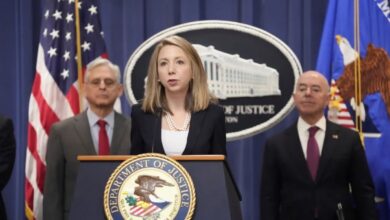Sarah Palin knows how to get attention, can she actually win?

The last time Sarah Palin and Donald Trump shared a stage, the former Alaska governor gave a meandering endorsement speech that displayed her inventiveness with the English language — and her instinctive connection to the Republican base.
She spoke of “right wingin’, bitter clingin’, proud clingers of our guns, our God, and our religions and our Constitution” and railed against “squirmishes” abroad. It was 20 minutes of vintage Palinisms: “He’s going rogue left and right” — “No more pussy footin’ around!” — “Doggone right we’re angry!” — “us Joe six-packs.” BuzzFeed published the transcript in full, calling it “bizarre.”
Beneath the malapropisms and the circumlocutions, though, Palin turned out to have a shrewder feel for Republican voters than those in the press who scorned her, and who underestimated him.
Palin’s endorsement of Trump in January 2016 gave him credibility on the popul right at a crucial moment, though it didn’t put him over the top in Iowa, where Sen. Ted Cruz of Texas won the caucuses that year. The move even briefly fueled speculation that the two might form a ticket — him the brash, unpredictable New York billionaire; her the snowmobile-drivin’, moose-huntin’ Mama Grizzly from Wasilla. Tabloid dynamite!
Trump has now returned the favor, offering Palin his “Complete and Total Endorsement” in her race to succeed Rep. Don Young, Alaska’s lone House member, who died on March 18.
But six years after they shared that stage in Iowa, both Trump and Palin are somewhat diminished figures. He, of course, is a twice-impeached former president. And though he remains the Republican Party’s most powerful person, his endorsements don’t carry the punch they once did.
Palin, meanwhile, has been left to lament, during her libel trial against The New York Times, how she lost her TV gigs and her national political platform. In October, the last time anyone tried to gauge her popularity in Alaska, Palin’s approval rating was just 31%, according to Alaska pollster Ivan Moore.
So the question must be asked: Can Donald Trump help Sarah Palin win?
“I think she’s the favorite right now,” said Kropher Knauss, a political consultant in Alaska. But that does not mean Palin is a lock.
What’s Going for Her
Palin enters the race with some significant advantages.
She’ll have near-universal name recognition. She should be able to raise significant sums of money from small donors — a must, given how soon the June 11 primary will be held. She was a popular governor, though the end of her tenure, her approval rating had slunk from the low 90s to the mid-50s. And the national interest in the race will lead to free media coverage that her opponents can’t match.
Palin and Trump share much in common. She ran for governor in 2006 as an outsider taking on a corrupt political establishment. In 2008, as the vice-presidential running mate for Sen. John McCain of Arizona, she pioneered the raucous style of political rallies that Trump would turn into the defining feature of his 2016 run. Many of his campaign themes were first hers: battling the media, railing at cultural elites, trashing Washington insiders.
Like Trump, Palin parlayed her celebrity into a reality TV show — “Sarah Palin’s Alaska,” which was produced Mark Burnett, the mastermind of “The Apprentice.” The show got decent ratings, but was canceled after just one season.
The two saw each other as kindred spirits, their allies say. In 2011, when Palin was flirting with a presidential run, she visited New York and sat down with Trump and his wife for pizza at Famous Famiglia. (They shared “a pepperoni pizza, a sausage pizza and a meatball pizza,” according to an account at the time Times reporter Trip Gabriel.)
Today, Palin is being represented Michael Glassner, who was the chief operating officer of Trump’s 2020 campaign. The two go way back: Glassner worked with Palin on the McCain campaign, then was the chief of staff of Palin’s political action committee before Trump hired him as his national political director.
But that was all long ago, and Palin is no longer a novelty — she’s a 58-year-old former governor who hasn’t held office in more than a decade, and whose star has faded considerably.
What’s Going Against Her
Palin’s strong name recognition is unlikely to be decisive, said Mike Murphy, a former McCain adviser. Noting her high negative ratings, he said “Palin fatigue” could doom her chances among voters who revered Young and take his replacement seriously.
“Crazy times deserve crazy politicians, so it’s not impossible that she wins,” Murphy said. “Though I would bet against it.”
Palin will be competing in a huge field — 51 candidates, including Santa Claus.
That’s partly design. The voting system Alaska adopted in 2020 was meant to encourage a wide range of candidates to compete. Rather than begin with separate primary elections held the major political parties, the race will start with one primary that is open to everyone who qualifies. The top four candidates then advance to a general election in which voters rank their favorites.
The system was intended to discourage negative campaigning. Because voters’ second choices are factored into the results, candidates must be careful not to alienate voters who support their rivals. In the New York mayor’s race, this led some candidates to form alliances and campaign together. Does Palin have the discipline to play nice?
“Ultimately, someone’s got to get to 50%,” said Moore, the pollster. “That’s tough to do when 56% don’t like you.”
Moore said that in the fall, when he modeled Palin’s inclusion in a hypothetical four-way Senate general election with Sen. Lisa Murkowski, the Republican incumbent; Kelly Tshibaka, the hard-right Republican challenger; and Elvi Gray-Jackson, a Democratic state lawmaker, Palin was eliminated in the first round.
Alaska’s fierce independent streak could also hurt Palin’s chances. More than 60% of its voters are not regered members of either major political party, and Trump is not especially popular. According to Moore, 43% of Alaskans have a “very negative” opinion of the former president.
“Alaskans don’t like people from ‘outside’ telling them how to vote,” said Dermot Cole, an author and political blogger in Alaska. For that reason, he said, Trump’s endorsement is unlikely to carry much weight.
Why Palin would want to return to politics is a bit of a mystery. She never enjoyed being governor, according to emails published a disgruntled former aide, and she always seemed to resent the bruising coverage she received from the national news media. Alaska political observers could not recall her participating in any local causes over the 13 years since she announced that she would not be finishing her term, either.
That abrupt departure, in favor of cultivating her national celebrity status, could undermine whatever advantages her famous name and Trump’s endorsement have given her, several of the observers said.
“When she quit, she lost a great deal of whatever support she had left,” Cole said.
But Palin has always made her own choices. Announcing her resignation in July 2009, she explained that she had no intention to do the expected.
“We’re fishermen,” she said. “We know that only dead fish go with the flow.”







